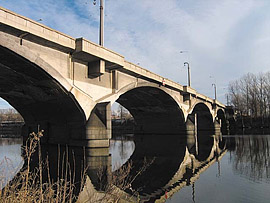
The concrete pillars of the Libeň Bridge are corroding, showed a survey
 |
The bridge, which dates back to 1928, has been in a state of emergency for a long time. Last year, the Prague Council approved a reconstruction, but the start date is unknown. The city is awaiting a decision from the Ministry of Culture, which is negotiating the declaration of the bridge as a monument.
"The bridge is founded on a load-bearing substrate composed of slates, but the concrete has a non-homogeneous macrostructure, is very porous, and degradation processes known as sulfate corrosion are taking place," said Dolínek.
Sulfate corrosion can occur in cement in the presence of sulfate ions. Their sources may be groundwater, a substance that was introduced during the production of concrete, or materials from the Vltava River. "There is a chemical reaction occurring, where new crystals form that expand and have a greater volume than the original material. This creates pressure and causes damage to the concrete structure," Kolísko explained.
Prague, along with the Technical Administration of Communications (TSK), will have the remaining pillars and other technical parts of the bridge inspected. The subsoil of the other pillars will also be examined. The Klokner Institute should complete its work by the end of this year.
What will happen to the bridge next is still unclear. Prague is waiting for the ministry to announce whether it will declare it a protected monument and potentially which parts will be included. "The missing decision is starting to limit us, as we cannot begin preparations for repairs. However, we can start monitoring the bridge," said Dolínek.
TSK plans to have other bridges examined using the same method. Among them may be the Hlávka, Legion, Palacký, and Barrandov bridges.
Since the Libeň Bridge was put into operation in 1928, its load-bearing structure has never been repaired. The authors of the bridge, which connects Holešovice and Libeň, are architect Pavel Janák and constructor František Mencl.
The Klokner Institute was founded in 1921 under the name Research and Testing Institute of Materials and Construction Structures. It now has four specialized departments, a composites center, an accredited laboratory, and since 1986, a forensic expert workplace in the field of construction.
The English translation is powered by AI tool. Switch to Czech to view the original text source.
0 comments
add comment
Related articles
3
25.09.2025 | The Prague Road Administration must not demolish the Libeň Bridge, confirmed the head of the Office for the Protection of Competition
0
11.09.2025 | The project for the construction of a replica of the Libeň Bridge is to be completed by the end of the year
0
30.07.2025 | TSK and Metrostav TBR filed a complaint against the decision of the Office for the Protection of Competition regarding the Libeň Bridge
0
22.07.2025 | Prague will build an underpass under the constructed section of the Libeň Bridge near Palmovka
0
01.07.2025 | <UOHS> prohibited <TSK> from repairing the <Libeň Bridge> according to the revised proposal
0
02.06.2025 | ÚOHS must reconsider the contract for the repair of the Libeň Bridge in Prague
0
24.04.2023 | Main work on the reconstruction of the Libeň Bridge will begin next year
0
07.09.2020 | Prague councilors postponed the discussion of the study on the repairs of the Libeň Bridge
0
02.09.2020 | The leadership of Prague will discuss the study of repairs to the Libeň Bridge next week
0
22.07.2020 | Prague will announce a contract for the reconstruction of the Libeň Bridge in the summer
0
10.09.2018 | Prague's YES proposes to build a residential bridge instead of the Libeň Bridge
0
11.07.2017 | On the Libeň Bridge in Prague, static tests have started
0
26.02.2016 | Prague will not demolish Libeňský Bridge, but will repair it, the councilors decided
0
27.01.2016 | Technical Museum opened an exhibition about the Libeň Bridge
0
22.01.2016 | The ministry will initiate proceedings for the declaration of the Libeň Bridge as a monument
0
15.01.2016 | The Prague Libeň Bridge is to be sensitively reconstructed according to IPR
0
01.10.2015 | Experts from ČVUT will assess whether it is necessary to demolish the Libeň Bridge
0
10.09.2015 | The Libeň Bridge in Prague may not be rebuilt, just repaired
0
03.08.2015 | The Czech Chamber of Architects opposes the expansion of the Libeň Bridge
0
30.06.2013 | Prague Bridges: the worst off is the Libeň Bridge











